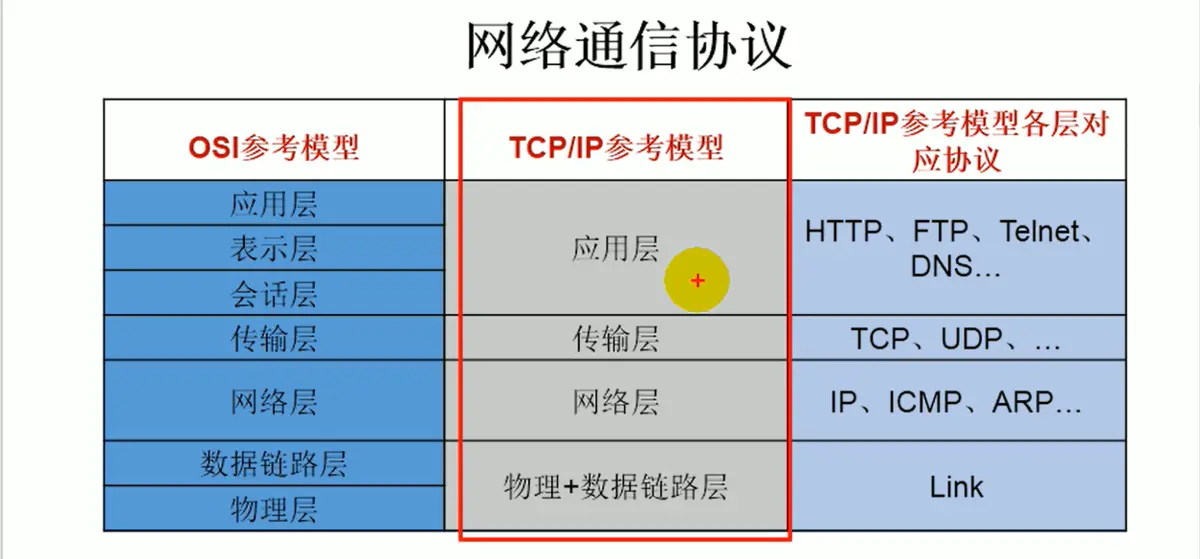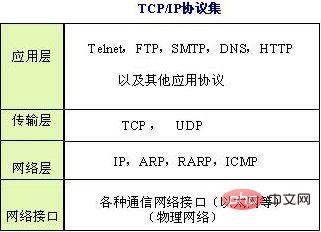
Application layer protocols include: 1. Telnet, which allows users on one machine to log in to a remote machine and perform work; 2. FTP, which provides the ability to move files from one machine to another. method on each machine; 3. SMTP is a protocol that provides email transmission; 4. SNMP is a standard protocol used to manage network nodes in IP networks; 5. DNS is mainly used to transfer familiar The URL is "translated" into an IP address that the computer can understand; 6. HTTP is a request-response protocol used to obtain the home page on the WWW.

The operating environment of this tutorial: Windows 7 system, Dell G3 computer.
TCP/IP is a reference model. It divides the network into four layers based on the OSI reference model, and each layer has its own corresponding protocol.

Among them, the application layer deals directly with users and application programs, and is responsible for providing interfaces to software so that programs can use network services. Network services here include file transfer, file management, email message processing, etc.
Typical application layer protocols include Telnet, FTP, SMTP, SNMP, DNS, HTTP, etc.

1. Telnet protocol
The Telnet protocol allows users on one machine to log in to a remote machine and perform work ;
The Telnet protocol is a member of the TCP/IP protocol family and is the standard protocol and main method for Internet remote login services. It provides users with the ability to complete remote host work on their local computer. Use the telnet program on the end user's computer to connect to the server. Terminal users can enter commands into the telnet program, and these commands will be run on the server as if they were entered directly on the server's console. You can control the server locally. To start a telnet session, you must enter your username and password to log into the server. Telnet is a commonly used method to remotely control web servers.
2. FTP protocol
FTP protocol provides a method to move files from one machine to another;
FTP (File Transfer Protocol) is one of the protocols in the TCP/IP protocol group. The FTP protocol consists of two components, one is the FTP server, and the other is the FTP client. The FTP server is used to store files, and users can use the FTP client to access resources located on the FTP server through the FTP protocol. When developing a website, the FTP protocol is usually used to transfer web pages or programs to the web server. In addition, because FTP transmission efficiency is very high, this protocol is generally used when transmitting large files on the network.
By default, the FTP protocol uses TCP ports 20 and 21, of which 20 is used to transmit data and 21 is used to transmit control information. However, whether to use port 20 as the data transmission port is related to the transmission mode used by FTP. If active mode is used, the data transmission port is 20; if passive mode is used, the final port to be used must be decided through negotiation between the server and the client.
3. SMTP protocol
The SMTP protocol is used to send and receive emails;
SMTP is a protocol that provides reliable and effective email transmission. protocol. SMTP is an email service built on the FTP file transfer service. It is mainly used to transfer email information between systems and provide notifications about incoming letters. SMTP is independent of a specific transmission subsystem and only requires the support of a reliable and orderly data flow channel. One of the important features of SMTP is its ability to transmit emails across the network, that is, "SMTP mail relay". Using SMTP, mail transmission can be realized between processing processes on the same network, and mail transmission between a processing process and other networks can also be realized through a relay or gateway.
4. SNMP protocol
SNMP is a standard specially designed for managing network nodes (servers, workstations, routers, switches, HUBS, etc.) in IP networks protocol, which is an application layer protocol. SNMP enables network administrators to manage network performance, identify and resolve network problems, and plan for network growth. Network management systems are notified of network problems by receiving random messages (and event reports) via SNMP.
The predecessor of SNMP is Simple Gateway Monitoring Protocol (SGMP), which is used to manage communication lines. Subsequently, people made great modifications to SGMP, especially adding SMI and MIB that conform to the Internet definition. The improved protocol is the famous SNMP. The SNMP network management framework based on TCP/IP is the current standard in the industry and consists of three main parts, namely the management information structure SMI (Structure of Management Information), the management information base MIB and the management protocol SNMP.
SMI defines the organization and identification of information used by the SNMP framework, and provides templates for MIB to define management objects and use management objects.
MIB defines a collection of management objects that can be accessed through SNMP.
The SNMP protocol is an application layer protocol that defines how the network manager reads and writes the MIB object of the agent process.
MIB in SNMP is a tree-like database. The object managed by MIB is the end node of the tree. Each node has a unique location and unique name. IETF stipulates management information base The object identifier (OID, Object Identifier) is uniquely specified, and its naming rule is that the name of the parent node is used as the prefix of the name of the child node
5, DNS protocol
Domain Name System (Domain Name System, DNS) is a system on the Internet that solves the naming of online machines. Just like when visiting a friend, you first need to know how to get to someone else's house. When a host wants to access another host on the Internet, it must first know its address. The IP address in TCP/IP is composed of four numbers separated by "." The composition is always not as convenient to remember as the name, so the domain name system is used to manage the correspondence between names and IPs.
Although nodes on the Internet can be uniquely identified by IP addresses and can be accessed through IP addresses, even if the 32-bit binary IP address is written as four ten-digit numbers from 0 to 255, Still too long and too difficult to remember. Therefore, people invented the domain name (Domian Name), which can associate an IP address with a group of meaningful characters. When a user visits a website, he or she can enter either the IP address of the website or its domain name. The two are equivalent for access. For example: the IP address of Microsoft's Web server is 207.46.230.229, and its corresponding domain name is www.microsoft.com. Regardless of whether the user enters 207.46.230.229 or www.microsoft.com in the browser, the user can access its Web website.
A company's Web website can be regarded as its online portal, and the domain name is equivalent to its house address. Usually the domain name uses the name or abbreviation of the company. For example, the domain name of Microsoft mentioned above is similar to: IBM's domain name is www.ibm.com, Oracle's domain name is www.oracle.com, Cisco's domain name is www.cisco.com, etc. When people want to visit a company's Web site and don't know its exact domain name, they will always enter the company name first as a test. However, a domain name consisting of a company's name or abbreviation may also be registered by other companies or individuals. There are even some companies or individuals that maliciously register a large number of domain names composed of the names of well-known companies, and then resell them to these companies at high prices to make profits. There are already some arbitration measures for domain name registration disputes, but to control this phenomenon from the source, a complete set of restriction mechanisms is needed, which is not yet available. Therefore, registering a domain name consisting of your own name as early as possible should be something that any company or institution, especially those well-known companies, must pay attention to. Some companies have already made protective registrations for domain names consisting of their own famous brands.
6. HTTP protocol
HTTP protocol is used to obtain the homepage on WWW.
Hyper Text Transfer Protocol (HTTP) is a simple request-response protocol that usually runs on top of TCP. It specifies what kind of messages the client may send to the server and what kind of response it gets. The headers of request and response messages are given in ASCII form; the message contents have a MIME-like format. This simple model was responsible for the early success of the Web because it made development and deployment very straightforward.
For more related knowledge, please visit theFAQcolumn!
The above is the detailed content of What are the protocols belonging to the application layer in the tcp ip reference model?. For more information, please follow other related articles on the PHP Chinese website!
 What is the encoding used inside a computer to process data and instructions?
What is the encoding used inside a computer to process data and instructions? What does Metaverse Concept Stock mean?
What does Metaverse Concept Stock mean? Reasons why phpstudy cannot be opened
Reasons why phpstudy cannot be opened Why can't my mobile phone make calls but not surf the Internet?
Why can't my mobile phone make calls but not surf the Internet? How to use html for web navigation
How to use html for web navigation How to round in Matlab
How to round in Matlab How to modify the text in the picture
How to modify the text in the picture Computer blue screen code 0xc0000225
Computer blue screen code 0xc0000225